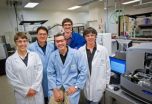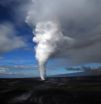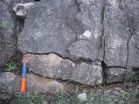(Press-News.org) Autism Spectrum Disorders (ASD), a category that includes autism, Asperger Syndrome, and Pervasive Developmental Disorder, are characterized by difficulty with social interaction and communication, or repetitive behaviors. The U.S. Centers for Disease Control and Management says that one in 88 children in the US is somewhere on the Autism spectrum — an alarming ten-fold increase in the last four decades.
New research by Dr. Mark Weiser of Tel Aviv University's Sackler Faculty of Medicine and the Sheba Medical Center has revealed that ASD appears share a root cause with other mental illnesses, including schizophrenia and bipolar disorder. At first glance, schizophrenia and autism may look like completely different illnesses, he says. But closer inspection reveals many common traits, including social and cognitive dysfunction and a decreased ability to lead normal lives and function in the real world.
Studying extensive databases in Israel and Sweden, the researchers discovered that the two illnesses had a genetic link, representing a heightened risk within families. They found that people who have a schizophrenic sibling are 12 times more likely to have autism than those with no schizophrenia in the family. The presence of bipolar disorder in a sibling showed a similar pattern of association, but to a lesser degree.
A scientific leap forward, this study sheds new light on the genetics of these disorders. The results will help scientists better understand the genetics of mental illness, says Dr. Weiser, and may prove to be a fruitful direction for future research. The findings have been published in the Archives of General Psychiatry.
All in the family
Researchers used three data sets, one in Israel and two in Sweden, to determine the familial connection between schizophrenia and autism. The Israeli database alone, used under the auspices of the ethics committees of both the Sheba Medical Center and the Israeli Defense Forces, included anonymous information about more than a million soldiers, including patients with schizophrenia and ASD.
"We found the same results in all three data sets," he says, noting that the ability to replicate the findings across these extensive databases is what makes this study so significant.
Understanding this genetic connection could be a missing link, Dr. Weiser says, and provides a fresh direction for study. The researchers are now taking this research in a clinical direction. For now, though, the findings shouldn't influence the way that doctors treat patients with either illness, he adds.
###This work was done in collaboration with researchers at the University of North Carolina, Karolinska Institute in Sweden, Kings College London, and the Israeli Defense Force Medical Corps.
American Friends of Tel Aviv University (www.aftau.org) supports Israel's leading, most comprehensive and most sought-after center of higher learning. Independently ranked 94th among the world's top universities for the impact of its research, TAU's innovations and discoveries are cited more often by the global scientific community than all but 10 other universities.
Internationally recognized for the scope and groundbreaking nature of its research and scholarship, Tel Aviv University consistently produces work with profound implications for the future.
Are schizophrenia and autism close relations?
Tel Aviv University researcher discovers that family history of schizophrenia is a risk factor for autism
2012-10-23
ELSE PRESS RELEASES FROM THIS DATE:
NASA sees active region on the sun emit another flare
2012-10-23
VIDEO:
Video of the Oct. 22, 2012, solar flare as captured by NASA's Solar Dynamics Observatory in the 131 and 304 Angstrom wavelengths. LINK TO HIGHEST RESOLUTION VIDEO: ...
Quasar may be embedded in unusually dusty galaxy
2012-10-23
Hubble astronomers have looked at one of the most distant and brightest quasars in the universe and are surprised by what they did not see: the underlying host galaxy of stars feeding the quasar. The best explanation is that the galaxy is shrouded in so much dust that the stars are completely hidden everywhere. Astronomers believe that the James Webb Space Telescope will reveal the galaxy.
All but the very first galaxies contain some dust—the early universe was dust-free until the first generation of stars started making dust through nuclear fusion. As these stars aged ...
Is declining medical imaging use driving up hospital stays and medical costs?
2012-10-23
A new report by the Harvey L. Neiman Health Policy Institute shows that the length of the average hospital stay in the United States has increased at the same time as use of medical imaging scans has declined. It is unclear if the trends are related, but potentially important, as hospital admissions are among the largest, and fastest growing, health care costs. More research is needed to assess the potential negative impact of government and private insurer imaging reductions on overall medical costs and patient safety.
"Lawmakers, regulators and medical professionals ...
Making transport a driver for development in Africa
2012-10-23
A new report by a panel of international experts highlights policies to improve air quality road safety and congestion, supporting African development.
Transport is playing a big role in delivering economic development to Africa. But as the demand for transport grows and cities expand, policy makers need to tackle transport challenges to make sure that all parts of society can benefit from this central driver of jobs and growth.
"Transport policies in Africa are of critical importance to the delivery of sustainable cities, healthy citizens and poverty eradication," ...
Training your robot the PaR-PaR way
2012-10-23
Teaching a robot a new trick is a challenge. You can't reward it with treats and it doesn't respond to approval or disappointment in your voice. For researchers in the biological sciences, however, the future training of robots has been made much easier thanks to a new program called "PaR-PaR."
Nathan Hillson, a biochemist at the U.S. Department of Energy (DOE)'s Joint BioEnergy Institute (JBEI), led the development of PaR-PaR, which stands for Programming a Robot. PaR-PaR is a simple high-level, biology-friendly, robot-programming language that allows researchers to ...
Study explains connection between Hawaii's dueling volcanoes
2012-10-23
HOUSTON -- (Oct. 23, 2012) -- A new Rice University-led study finds that a deep connection about 50 miles underground can explain the enigmatic behavior of two of Earth's most notable volcanoes, Hawaii's Mauna Loa and Kilauea. The study, the first to model paired volcano interactions, explains how a link in Earth's upper mantle could account for Kilauea and Mauna Loa's competition for the same deep magma supply and their simultaneous "inflation," or bulging upward, during the past decade.
The study appears in the November issue of Nature Geoscience.
The research offers ...
Oxygen's ups and downs in the early atmosphere and ocean
2012-10-23
RIVERSIDE, Calif. — Most researchers imagine the initial oxygenation of the ocean and atmosphere to have been something like a staircase, but with steps only going up. The first step, so the story goes, occurred around 2.4 billion years ago, and this, the so-called Great Oxidation Event, has obvious implications for the origins and evolution of the first forms of eukaryotic life. The second big step in this assumed irreversible rise occurred almost two billion years later, coinciding with the first appearances and earliest diversification of animals.
Now a team led ...
Don't be so fast to judge a cat by its color, new study warns
2012-10-23
Just like humans, domestic cats are often judged by their color, and the media and folklore help perpetuate these stereotypes. Take the snobbish, aloof, white kitty who promotes "Fancy Feast," and spooky images of black cats, which can be associated with bad luck and witches, especially around Halloween.
Interested in the link between how cat color influences adoption rates, a University of California, Berkeley, researcher surveyed 189 people with experience of cats as pets and found that they were more likely to assign positive personality traits to orange cats and less ...
Influence in times of crisis: How do men and women evaluate precarious leadership positions?
2012-10-23
We've all heard of the "glass ceiling" but the recent economic crisis has illuminated another workplace phenomenon: the "glass cliff." Women seem to be overrepresented in precarious leadership positions at organizations going through crisis. Evidence is growing that more feminine leadership traits, such as being understanding and tactful, are believed to be desirable under such circumstances, causing people to make a "think crisis – think female" association.
But is it that women are always passively selected into these jobs or do they sometimes also actively seek them ...
Complete mitochondrial genome sequences of ancient New Zealanders
2012-10-23
In a landmark study, University of Otago researchers have achieved the feat of sequencing complete mitochondrial genomes for members of what was likely to be one of the first groups of Polynesians to settle New Zealand and have revealed a surprising degree of genetic variation among these pioneering voyagers.
The Otago researchers' breakthrough means that similar DNA detective work with samples from various modern and ancient Polynesian populations might now be able to clear up competing theories about the pathways of their great migration across the Pacific to New Zealand.
Results ...
LAST 30 PRESS RELEASES:
Support for parents with infants at pediatric check-ups leads to better reading and math skills in elementary school
Kids’ behavioral health is a growing share of family health costs
Day & night: Cancer disrupts the brain’s natural rhythm
COVID-19 vaccination significantly reduces risk to pregnant women and baby
The role of vaccination in maternal and perinatal outcomes associated with COVID-19 in pregnancy
Mayo Clinic smartwatch system helps parents shorten and defuse children's severe tantrums early
Behavioral health spending spikes to 40% of all children’s health expenditures, nearly doubling in a decade
Digital cognitive behavioral treatment for generalized anxiety disorder
Expenditures for pediatric behavioral health care over time and estimated family financial burden
Air conditioning in nursing homes and mortality during extreme heat
The Alps to lose a record number of glaciers in the next decade
What makes a good proton conductor?
New science reporting guide published for journalists in Bulgaria
New international study reveals major survival gaps among children with cancer
New science reporting guide published for journalists in Turkey
Scientists develop a smarter mRNA therapy that knows which cells to target
Neuroanatomy-informed brain–machine hybrid intelligence for robust acoustic target detection
Eight SwRI hydrogen projects funded by ENERGYWERX
The Lundquist Institute and its start-up company Vitalex Biosciences Announces Strategic Advancement of Second-Generation fungal Vaccine VXV-01 through Phase 1 Trials under $40 Million Competitive Con
Fine particles in pollution are associated with early signs of autoimmune disease
Review article | Towards a Global Ground-Based Earth Observatory (GGBEO): Leveraging existing systems and networks
Penn and UMich create world’s smallest programmable, autonomous robots
Cleveland researchers launch first major study to address ‘hidden performance killer’ in athletes
To connect across politics, try saying what you oppose
Modulating key interaction prevents virus from entering cells
Project explores barriers to NHS career progression facing international medical graduates
Jeonbuk National University researchers explore the impact of different seasonings on the flavor perception of Doenjang soup
Two Keck Medicine of USC Hospitals named Leapfrog Top Teaching Hospitals
World-first discovery uncovers how glioblastoma tumours dodge chemotherapy, potentially opening the door to new treatments
A fatal mix-up: How certain gut bacteria drive multiple sclerosis
[Press-News.org] Are schizophrenia and autism close relations?Tel Aviv University researcher discovers that family history of schizophrenia is a risk factor for autism




